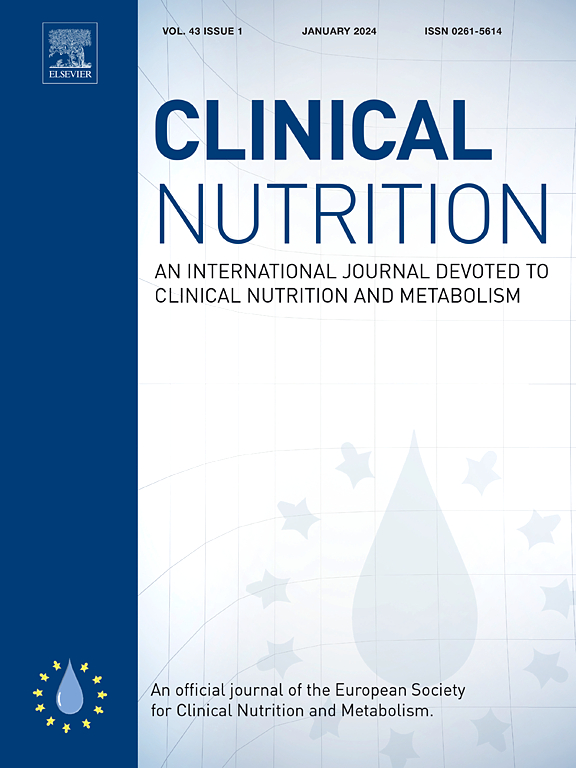Association between triglyceride-glucose related indices and severe infection requiring hospital admission or resulting in mortality among individuals with metabolic dysfunction-associated steatotic liver disease
IF 6.6
2区 医学
Q1 NUTRITION & DIETETICS
引用次数: 0
Abstract
Background and aims
Despite increasing evidence linking triglyceride-glucose (TyG) related indices with metabolic and cardiovascular outcomes, the associations with severe infection in individuals with metabolic dysfunction-associated steatotic liver disease (MASLD) remain unclear.
Methods
We analyzed data from a large population-based cohort, which included participants who were diagnosed with MASLD and enrolled in 2016 and 2017, with follow-up until December 2022. Severe infections were defined as those requiring hospital admission or resulting in mortality. Multivariate Cox and restricted cubic spline (RCS) regression models were used to evaluate the associations between TyG-related indices and severe infection among participants with MASLD. Additionally, we examined these associations within subgroups defined by age, sex, hypertension, diabetes, obesity, and hyperlipidemia.
Results
Among the 11,782 eligible participants with MASLD (mean age 57.02 years; 34.36 % male), a total of 898 (7.62 %) severe infections occurred during the median follow-up of 5.71 years. The multivariate Cox regression analyses revealed that high levels of TyG (HR = 1.175, 95%CI = 1.049–1.315), TyG-BMI (HR = 1.004, 95%CI = 1.001–1.006), and TyG-WC (HR = 1.002, 95%CI = 1.001–1.003) indices were significantly associated with the severe infection in patients with MASLD. The RCS curves showed positive linear correlations between three TyG-related indices with severe infection in MASLD. Subgroup analyses showed these associations were more pronounced among MASLD patients without obesity. Additionally, incorporating TyG-related indices into the basic model considerably improved the predictive ability for severe infection.
Conclusions
Our study indicated that a high TyG-related indices are associated with an increased risk of severe infection in MASLD patients. TyG-related indices would be the surrogate biomarkers for the follow-up of the MASLD population.
甘油三酯-葡萄糖相关指标与代谢功能障碍相关的脂肪变性肝病患者需要住院或导致死亡的严重感染之间的关系
背景和目的尽管有越来越多的证据表明甘油三酯-葡萄糖(TyG)相关指数与代谢和心血管结局有关,但代谢功能障碍相关性脂肪性肝病(MASLD)患者严重感染的相关性仍不明确。严重感染定义为需要入院治疗或导致死亡的感染。我们使用多变量 Cox 和限制性立方样条曲线 (RCS) 回归模型来评估 MASLD 患者中 TyG 相关指数与严重感染之间的关系。结果在11782名符合条件的MASLD患者(平均年龄57.02岁;34.36%为男性)中,共有898人(7.62%)在5.71年的中位随访期间发生了严重感染。多变量Cox回归分析显示,高水平的TyG(HR = 1.175,95%CI = 1.049-1.315)、TyG-BMI(HR = 1.004,95%CI = 1.001-1.006)和TyG-WC(HR = 1.002,95%CI = 1.001-1.003)指数与MASLD患者的严重感染显著相关。RCS曲线显示,三种TyG相关指数与MASLD严重感染呈正线性相关。亚组分析显示,这些关联在无肥胖症的MASLD患者中更为明显。结论我们的研究表明,TyG相关指数高与MASLD患者严重感染风险增加有关。TyG相关指数将成为随访MASLD人群的替代生物标志物。
本文章由计算机程序翻译,如有差异,请以英文原文为准。
求助全文
约1分钟内获得全文
求助全文
来源期刊

Clinical nutrition
医学-营养学
CiteScore
14.10
自引率
6.30%
发文量
356
审稿时长
28 days
期刊介绍:
Clinical Nutrition, the official journal of ESPEN, The European Society for Clinical Nutrition and Metabolism, is an international journal providing essential scientific information on nutritional and metabolic care and the relationship between nutrition and disease both in the setting of basic science and clinical practice. Published bi-monthly, each issue combines original articles and reviews providing an invaluable reference for any specialist concerned with these fields.
 求助内容:
求助内容: 应助结果提醒方式:
应助结果提醒方式:


